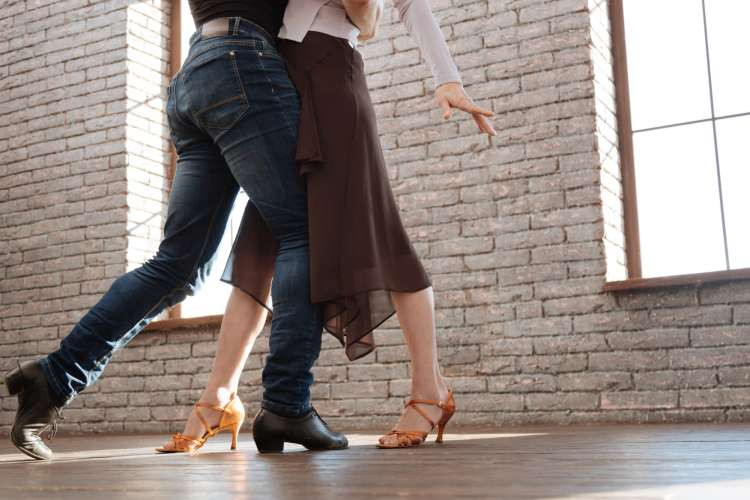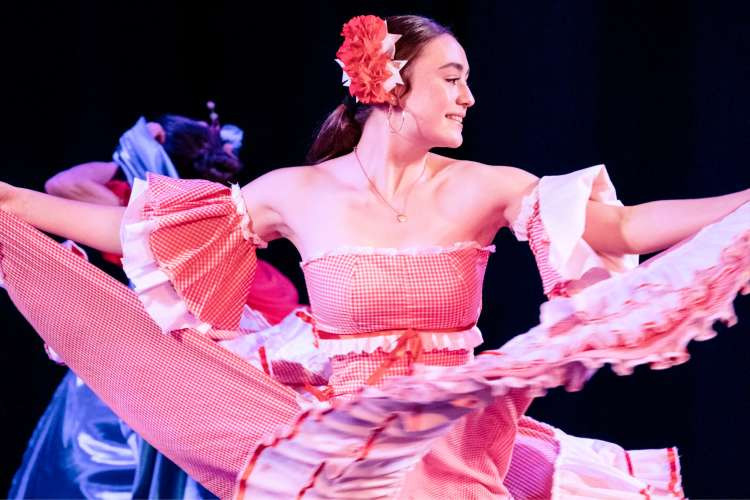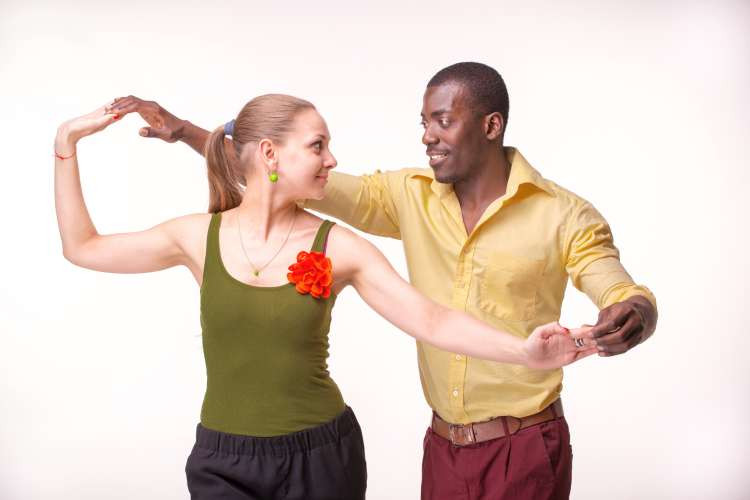Are you ready to add some Latin spice to your dance repertoire? Cumbia Dance is a vibrant and engaging style that’s surprisingly easy to pick up, making it perfect for beginners. If you’ve been looking to learn how to dance cumbia, now is the perfect time to lace up your dance shoes and immerse yourself in the rhythm! This guide will walk you through everything you need to know to start dancing cumbia, from its rich history and captivating music to the basic steps and partner techniques.
Learning to dance cumbia isn’t just fun; it’s also fantastic for your well-being. Experts at the Better Health Channel emphasize the numerous physical and mental benefits of dance, including improved cardiovascular health and increased self-esteem. So, let’s dive into the world of cumbia and discover how you can get moving and grooving!
Getting Started with Cumbia Dance
Dance Classes: Your Fast Track to Cumbia Mastery
One of the most effective and enjoyable ways to learn cumbia dance is by joining dance classes. Whether you prefer the energy of in-person studios or the convenience of online dance classes, professional instruction can make a significant difference. In a cumbia dance class, you’ll benefit from detailed guidance from experienced instructors, personalized feedback, and the opportunity to practice with partners. Learning in a class environment is not only efficient but also a great social experience, especially when you bring friends along or meet fellow dance enthusiasts. If you’re searching for “dance classes near me” or specifically looking for dance classes in NYC or dance classes in Las Vegas, explore local options to kickstart your cumbia journey. And for a flexible gift idea, consider a Classpop! gift card, allowing recipients to choose their preferred dance style and class.
 Enthusiastic students learning cumbia dance steps in a vibrant dance class setting, highlighting the fun and social aspects of cumbia dance lessons.
Enthusiastic students learning cumbia dance steps in a vibrant dance class setting, highlighting the fun and social aspects of cumbia dance lessons.
Practice Makes Perfect: Cumbia at Your Own Pace
Consistent practice is key to mastering cumbia dance and truly internalizing the steps. The beauty of cumbia is its accessibility – you can easily practice at home! All you need is some captivating cumbia music, a positive attitude, and this guide to remind you of the steps. YouTube offers a wealth of free cumbia music playlists to get you started. Keep reading to delve deeper into the history of cumbia, explore its musical roots, and break down the essential cumbia steps and rhythms.
Unveiling the Essence of Cumbia
Cumbia’s Rich History: Tracing its Origins
The story of cumbia dance and music begins in 19th-century Colombia, specifically in the coastal region of San Basilio. Emerging as a folk dance, cumbia was a cultural melting pot, blending indigenous Colombian traditions with the rhythms and movements of enslaved Africans brought by Spanish colonizers. This fusion created a unique and expressive dance form. In the 1940s, Colombian singer Luis Carlos Meyer Castandet played a pivotal role in popularizing cumbia internationally. His collaboration with Mexican orchestra director Rafael de Paz introduced cumbia to Mexico, where it quickly gained popularity and evolved into Mexican cumbia. Around the same time, cumbia’s infectious rhythm spread throughout Latin America, reaching Peru, Chile, Argentina, and beyond. Today, cumbia stands as one of the most beloved Latin dances worldwide, enjoyed by both professional dancers and casual enthusiasts.
The Soul of Cumbia: Its Captivating Music
Cumbia music is often hailed as the “mother of Latin music,” a testament to its foundational influence on many genres. It’s characterized by a vibrant blend of African drum rhythms, Colombian flute melodies, and the percussive sounds of maracas. Over time, cumbia’s instrumentation has expanded, incorporating instruments like guitars, claves, accordions, and bass guitars, enriching its sonic texture. Cumbia music is energetic and lively, often described as a captivating midpoint between salsa and samba. While salsa steps might not perfectly align with cumbia music, dancing cumbia steps to salsa music is a popular and enjoyable variation, particularly in Central America. To truly immerse yourself in learning cumbia dance, make sure you have authentic cumbia music playing as you practice!
[ A cumbia dancer elegantly dressed in traditional pink cumbia attire, showcasing the cultural richness of cumbia dance.]
A cumbia dancer elegantly dressed in traditional pink cumbia attire, showcasing the cultural richness of cumbia dance.]
Mastering the Cumbia Steps
The Foundational Cumbia Step: The Back-Break Basic
The “back-break basic” step is the cornerstone of cumbia dance and thankfully, it’s quite beginner-friendly. This step follows a simple four-count pattern:
- Count 1: Step back diagonally with your right foot, creating approximately a 45-degree angle. Your right toe should be almost in line with your back heel, maintaining a comfortable distance between your feet.
- Count 2: Step in place with your left foot.
- Count 3: Bring your right foot back to its starting position, next to your left foot.
- Count 4: Pause and shift your weight slightly. You can add a touch of flair by lightly tapping your right heel.
Repeat these steps, alternating sides. On the next count 1, step back diagonally with your left foot. Then, step in place with your right foot on count 2, bring your left foot back to place on count 3, and pause on count 4. When you first learn cumbia dance, practice these steps slowly to build muscle memory and gradually increase your speed as you become more comfortable. Soon, the back-break basic will become second nature, and you’ll be ready to explore more stylistic and advanced elements of cumbia.
Partnering in Cumbia: Leading and Following
When dancing cumbia with a partner, understanding the lead and follow roles is essential for smooth coordination. While cumbia doesn’t traditionally dictate different steps for leaders and followers, synchronized movement requires partners to start on opposite feet. Typically, the leader (often, but not always, a man) begins by stepping back with their left foot, while the follower (often, but not always, a woman) starts by stepping back with their right foot. This mirroring action ensures that your movements flow in harmony and avoids stepping on each other’s feet. Begin by facing your partner, raising your arms gently, and holding hands. As you become more comfortable with the basic step together, you can gradually incorporate more intricate partner moves and styling.
[ A couple gracefully dancing cumbia, demonstrating the partner connection and synchronized movement in cumbia dance.]
A couple gracefully dancing cumbia, demonstrating the partner connection and synchronized movement in cumbia dance.]
Elevating Your Cumbia: Advanced Moves
Once you and your partner have mastered the basic 4-count back-break step and can maintain a steady rhythm, it’s time to inject more personality and excitement into your cumbia. This is where you can start adding hip dips, spins, and other stylistic variations. A crucial aspect of learning advanced cumbia dance is developing a feel for the music. After solidifying the basic 8-count pattern (combining both right and left side basic steps), dedicate time to practicing the basic step to cumbia music. Let your hips and body sway naturally with the beat, allowing the music to guide your movement. As you and your partner become more attuned to the rhythm and each other, experiment with different moves and have fun exploring the expressive possibilities of cumbia.
Adding a Turn to Your Cumbia
Incorporating turns is a popular and visually appealing advanced cumbia move. To execute a turn:
- Starting Position: Begin face-to-face with your partner, holding hands.
- Step Back Together: Both partners step back simultaneously while maintaining hand contact.
- Release and Initiate Turn: Release hands. The leader uses their left hand to gently guide the follower forward, prompting them to step forward onto their right foot.
- Follower’s Pivot: The follower should firmly plant their right foot – this becomes their pivot point for the turn. As the follower plants their right foot, the leader takes hold of the follower’s right hand, raising their arm to initiate the turn.
- Complete the Turn: To finish the turn, the leader steps forward and slightly to the side on their left foot, guiding the follower to complete the turn and return to the neutral starting position, facing each other.
The count for the turn sequence is:
- Count 1: Both partners step back.
- Count 2: Follower steps forward, and the turn begins.
- Count 3: Leader steps forward and to the side, completing the turn.
- Count 4: Partners arrive back at the neutral starting position.
[ A dance instructor guiding a student through cumbia turns, showcasing the elegance and coordination of advanced cumbia moves.]
A dance instructor guiding a student through cumbia turns, showcasing the elegance and coordination of advanced cumbia moves.]
Now, you’re well-equipped to turn up the music and begin your exciting journey into cumbia dance! Whether you choose to learn independently, with a partner, or in a structured dance class, remember that cumbia’s steps are inherently beginner-friendly. This captivating Latin dance is accessible and enjoyable for everyone, regardless of prior dance experience. The most important thing is to have fun as you learn how to dance cumbia! Keep practicing, embrace the rhythm, and who knows – you might just become a passionate cumbia dancer yourself.
For further inspiration and opportunities to explore dance and other creative activities, be sure to check out more experiences available on Classpop!
